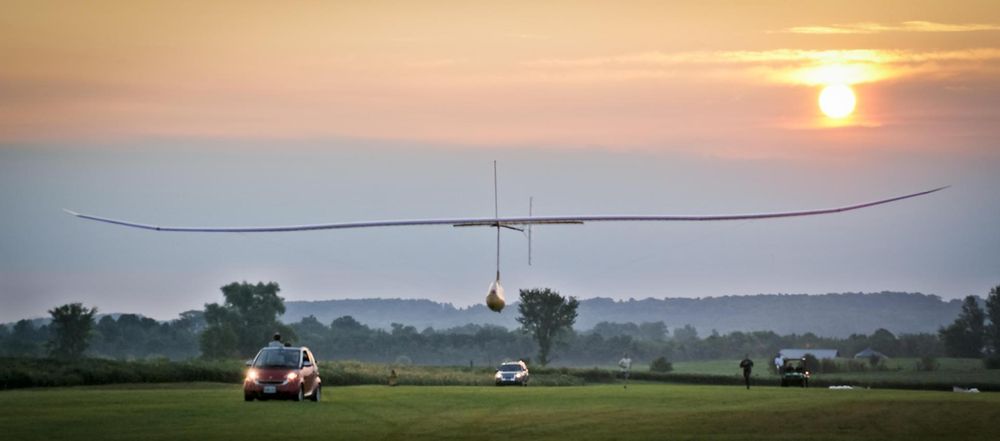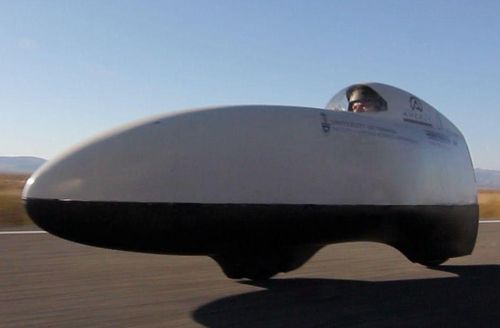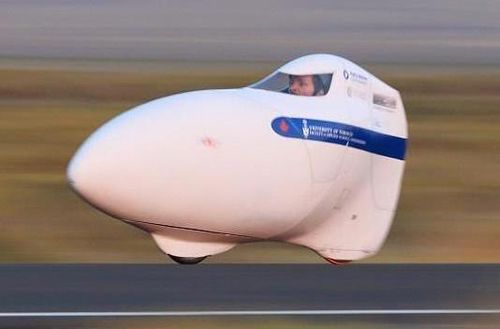University of Toronto Human Powered Vehicle
The University of Toronto Human Powered Vehicle Design Team (HPVDT) is a design team focused around designing and building vehicles solely using human power. The projects include the Human Powered Ornithropter (HPO) project and the Human Powered Vehicle (HPV) project.
Human Powered Ornithropter
During the summer of 2008 a group of graduate students founded the club to design and build an ornithopter (wing-flapping aircraft) that used human power alone. The project was headed by Todd Reichert (NΨ 0T4 + Film) and Cameron Robertson (NΨ 0T8). The ornithopter was successfully completed and made a record setting flight as the first human powered ornithopter.
Human Powered Vehicle
After completing the ornithopter the team moved onto their the next project, the Human Powered Vehicle (HPV). The goal was to design an aerodynamically faired bicycle capable of reaching speeds in excess of 100 km/h.
2008 - 2009
No vehicle was successfully built except for a carbon fibre frame which went on to become a training vehicle.
2009 - 2010
The team built and competed with ACE. The team competed at the ASME Human Powered Vehicle Challenge and at Battle Mountain Human Powered Speed Challenge. ACE's top speed was approximately 100 km/h. The team scored second in both men and women sprint events, as well as third place overall in the Speed Class at the ASME event, a great performance for a new team. Furthermore, the team scored the collegiate speed record at the Battle Mountain event, with a 103km/h run. This was the first year undergraduate students were a part of the team. ACE used an aluminum frame supported in a fairing constructed from Kevlar and carbon fibre. It's total length was approximately 9 ft.
2010 - 2011
Taking what they learned in previous years, Vortex was built. Vortex was superior to ACE in many ways: it boasted superior aerodynamics, simpler front wheel fairing, a removable drive-train mechanism and used a door rather than a split dividing the top from the bottom. It was also much smaller with a length of approximately 7 ft.
The team took Vortex to compete in the ASME HPVC, this year on the Indianapolis speedway. The team placed 1st in women's sprint, 2nd in men's sprint, 1st in endurance, 6th in utility and 3rd in design. The team was awarded 1st overall in the competition.
In September of 2011 the team competed in the Battle Mountain WHPSC again, this time in hopes of setting a world speed record. After a week of racing the team marked a top speed of 116.9 km/h by Todd Reichert, still well short of the world record.
2011 - 2012
HPVDT significantly redesigned all aspects of the design for the next iteration of speedbike. Led by co-captains Trefor Evans (NΨ 1T3) and Aidan Muller (MSE 1T3), the team proceeded to manufacture the Bluenose vehicle. This design boasted much-improved aerodynamics, highly-durable construction, revised steering geometry, and a new landing gear system.
Bluenose competed at the 2012 ASME HPVC, where it won awards in the Design and Sprint events. The team finished 4th overall.
During the summer of 2012, the core membership of HPVDT was recruited to the newly-formed AeroVelo Inc. design team. The group relocated to Tottenham, ON, where they designed and manufactured the Atlas human-powered helicopter until September.
WHPSC 2012 was disappointing. A variety of handling and visibility problems prevented Bluenose from reaching its potential, and the team failed to improve upon Vortex's top speed.
2012 - 2013
Knowing that Bluenose could be greatly improved for future high-speed events, the team decided to take a different approach for the more utility-oriented ASME event. A faired tricycle was designed, using many of the same structural features as the previous two-wheeled vehicles. This new vehicle - dubbed Celero - was slower, but far more stable and reliable than the team's previous entries.
Despite mediocre performance in the Design and Innovation categories, Celero placed well in both the Sprint and Endurance races. In fact, the Endurance race was won by an unusually-large margin; Celero finished the 2.5 hour event having covered nearly 20% more distance than the next-fastest vehicle. Overall, HPVDT finished 3rd in this competition. Shortly after this event, Calvin Moes (NΨ 1T3+PEY) was elected as the new Team Captain. Long may he rule!
Collaboration with AeroVelo on the human-powered helicopter continued through 2013 until that project achieved its goal of winning the coveted Sikorsky Prize in June. Following that success, HPVDT continued to collaborate with members of AeroVelo to revise certain aspect of the Bluenose speedbike in preparation for WHPSC 2013.
The 2013 World Human-Powered Speed Challenge remains one of HPVDT's greatest successes. With low-friction tires, a custom-built camera vision system, and four well-practiced riders, Bluenose was ready to go fast. Vortex was also tuned up for three of the team's less-experienced riders. Despite some handling problems early in the week-long event, Bluenose eventually reached a top speed of 125 km/h (alumnus rider Todd Reichert), while Calvin Moes and Trefor Evans both set collegiate records. The team finished with an unprecedented 3 riders over 75 MPH, and all seven riders set ambitious personal bests. HPVDT was presented with a one-time Innovation Award for our camera vision system, which was a vast improvement over other designs in terms of clarity, function, and reliability.
2013 - 2014
HPVDT built a leaning tricycle for the ASME HPVC event. It performed well in the Innovation and Speed events, but was mediocre in Design and Endurance. The team finished 7th overall.
During the summer of 2014, members of HPVDT collaborated with AeroVelo Inc. to design and build the Eta speedbike. With a myriad of new design features and unparalleled aerodynamic quality, Eta was a favorite among the HPV community to set a new speed record.
In order to better support the Eta project, HPVDT did not field any of its own vehicles at WHPSC 2014. Along with AeroVelo's top athlete Todd Reichert, HPVDT/AeroVelo riders Trefor Evans and Calvin Moes competed in the week of racing. Todd managed to set a personal best speed, but did not achieve the goal of a new world speed record. Following the competition, strategic differences between AeroVelo and HPVDT resulted in the two organizations ceasing large-scale collaboration. As part of this agreement, HPVDT retained the right to build a "clone" of the Eta speedbike.


